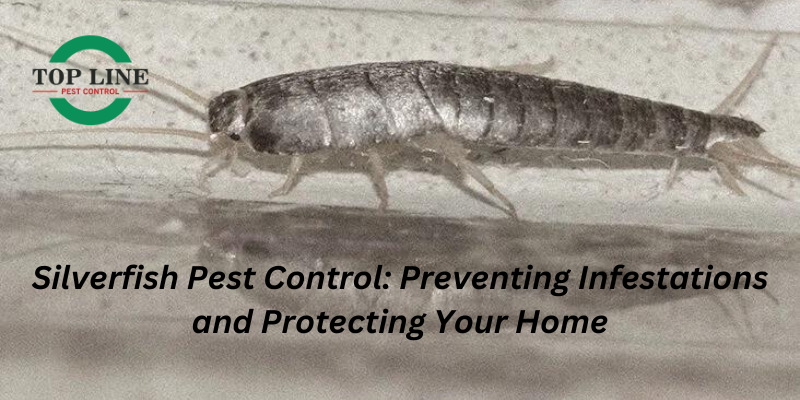Silverfish, those small, wingless, scaly insects that scurry across floors and hide in dark, moist areas, can be more than just a nuisance in your home. While these pests are not known to transmit diseases to humans, their presence can cause damage to valuable items, such as books, clothing, wallpaper, and other organic materials.
Effective silverfish pest control is essential for preventing infestations and protecting your home from the potential damage these insects can cause. In this article, we’ll explore strategies for silverfish pest control, tips for preventing infestations, and methods to protect your home from these unwanted pests.
What Are Silverfish?
Silverfish (Lepisma saccharina) are small, nocturnal insects that thrive in damp and humid environments. They are typically 1/2 to 1 inch long, with a teardrop-shaped body covered in silvery scales, which is why they are called “silverfish.”
Their long, slender bodies, combined with their quick, darting movements, make them look like tiny fish, although they are not related to aquatic species. Silverfish feed on a variety of materials, including paper, glue, and natural fibers like cotton, linen, and silk. They are attracted to starchy foods, which they can also feed on, such as cereals and flour.
Signs of a Silverfish Infestation
Recognizing a silverfish infestation early is crucial for preventing widespread damage. Look for these common signs:
- Visible Silverfish: Spotting silverfish scurrying across the floor, especially in the dark, is a clear sign of an infestation. You may also find them near baseboards, in attics, basements, and bathrooms.
- Damage to Personal Belongings: Silverfish are known to damage books, clothing, wallpaper, and other organic materials. Small holes, yellow stains, or areas with a shredded appearance on paper and fabric could indicate silverfish activity.
- Feces: Silverfish produce tiny black droppings, which may look like pepper grains. Finding these droppings is a strong indicator of their presence.
- Eggs: Silverfish eggs are tiny, white, and cylindrical. These may be laid in cracks or crevices near food sources.
How to Prevent Silverfish Infestations
Effective silverfish pest control starts with prevention. Here are some steps to reduce the chances of an infestation:
- Reduce Moisture: Silverfish thrive in humid environments. Reducing moisture in your home can discourage silverfish from settling in. Consider using dehumidifiers in damp areas like basements, bathrooms, and kitchens. Fix leaks in plumbing, and ensure proper ventilation throughout your home.
- Seal Cracks and Crevices: Silverfish can enter through tiny cracks and gaps in walls, windows, and doors. Sealing these openings with caulk can help prevent their entry.
- Proper Ventilation: Good airflow is essential to prevent the build-up of moisture. Ensure that your home is adequately ventilated, especially in areas prone to humidity, like attics, bathrooms, and basements.
- Remove Food Sources: Silverfish are attracted to starchy substances, including cereal, grains, and paper products. Store dry food items in airtight containers and avoid leaving crumbs or spilled food around. Keep your home clean and regularly vacuum areas where food can accumulate.
- Keep Your Home Dry: Silverfish are attracted to damp conditions. To minimize their appeal, use a dehumidifier in your home, especially in damp basements, bathrooms, and attics. Avoid excessive watering of plants indoors, as it can raise the humidity levels in your home.
Silverfish Pest Control Methods
If you already have a silverfish infestation, it’s important to take action immediately to eliminate them. Below are some effective pest control methods:
- Natural Remedies:
- Diatomaceous Earth: This fine powder made from the remains of tiny aquatic organisms can be sprinkled in areas where silverfish are active. It works by dehydrating the insects and causing them to die.
- Essential Oils: Silverfish dislike certain essential oils, such as lavender, cedarwood, and citrus. You can create a natural repellent by mixing a few drops of essential oil with water and spraying it in areas where silverfish are likely to hide.
- Insect Traps: Commercial silverfish traps are available to catch the pests. These traps use attractants like starch to lure silverfish in, where they become stuck. Placing traps near walls, baseboards, and other silverfish hotspots can help you monitor and control the infestation.
- Chemical Solutions:
- Insecticides: If the infestation is severe, you may need to resort to chemical insecticides. Look for insecticides that are specifically formulated to target silverfish. Always follow the manufacturer’s instructions and take care when applying chemicals indoors.
- Boric Acid: This is a common and effective insecticide for silverfish. Boric acid is toxic to insects but relatively safe for humans and pets when used correctly. Sprinkle it in areas where silverfish are seen and around cracks and crevices.
- Professional Pest Control: If the infestation is large or difficult to control, hiring a professional pest control service is often the most effective solution. Pest control experts can assess your home, determine the best course of action, and ensure that the silverfish problem is dealt with thoroughly.
Protecting Your Home From Future Silverfish Infestations
Once you have eliminated silverfish from your home, it’s important to take steps to ensure they don’t return:
- Maintain Dry Conditions: Keep the humidity levels low in your home and fix any leaks promptly. Using a dehumidifier in areas prone to moisture can greatly reduce the likelihood of future infestations.
- Regular Cleaning: Regularly vacuum and clean your home to remove food sources and debris that could attract silverfish. Pay special attention to dark, hidden areas like basements, attics, and behind furniture.
- Routine Inspections: Conduct periodic inspections for silverfish, particularly in areas where you have noticed activity before. Early detection can help you prevent another infestation from spreading.
Conclusion
Silverfish may seem like harmless pests, but they can cause significant damage to personal belongings and disrupt your peace of mind. By understanding their habits and taking the necessary preventive measures, you can keep silverfish out of your home.
Whether you rely on natural remedies, insecticides, or professional pest control services, staying vigilant and proactive is key to protecting your home from these destructive pests.
